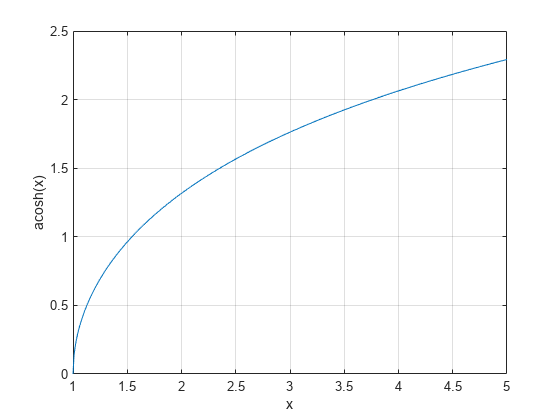acosh - Inverse hyperbolic cosine - MATLAB (original) (raw)
Main Content
Inverse hyperbolic cosine
Syntax
Description
`Y` = acosh([X](#mw%5Fd19f6c95-3d90-4888-b667-be67cc916d4a)) returns the inverse hyperbolic cosine of the elements of X. The function accepts both real and complex inputs. All angles are in radians.
Examples
Find the inverse hyperbolic cosine of the elements of vector X. The acosh function acts on X element-wise.
X = [2 -3 1+2i]; Y = acosh(X)
Y = 1×3 complex
1.3170 + 0.0000i 1.7627 + 3.1416i 1.5286 + 1.1437i
Plot the inverse hyperbolic cosine function over the interval 1≤x≤5.
x = 1:0.01:5; plot(x,acosh(x)) grid on xlabel('x') ylabel('acosh(x)')

Input Arguments
Hyperbolic cosine of angle, specified as a scalar, vector, matrix, multidimensional array, table, or timetable. The acosh operation is element-wise whenX is nonscalar.
Data Types: single | double | table | timetable
Complex Number Support: Yes
More About
For real values x in the domain x>1, the inverse hyperbolic cosine satisfies
For complex numbers z=x+iy, as well as real values in the domain − ∞<z≤ 1, the call acosh(z) returns complex results.
Extended Capabilities
Theacosh function fully supports tall arrays. For more information, see Tall Arrays.
Usage notes and limitations:
- Generates an error during simulation and returns
NaNin generated code when the input valuexis real, but the output should be complex. To get the complex result, make the input value complex by passing incomplex(x).
Usage notes and limitations:
- Generates an error during simulation and returns
NaNin generated code when the input valueXis real, but the output should be complex. To get the complex result, make the input value complex by passing incomplex(X).
The acosh function supports GPU array input with these usage notes and limitations:
- If the output of the function running on the GPU can be complex, then you must explicitly specify its input arguments as complex. For more information, see Work with Complex Numbers on a GPU (Parallel Computing Toolbox).
For more information, see Run MATLAB Functions on a GPU (Parallel Computing Toolbox).
Version History
Introduced before R2006a
The acosh function can calculate on all variables within a table or timetable without indexing to access those variables. All variables must have data types that support the calculation. For more information, see Direct Calculations on Tables and Timetables.